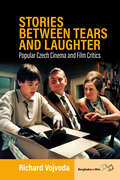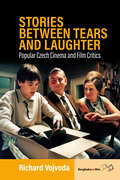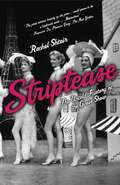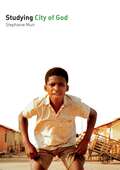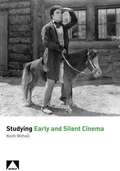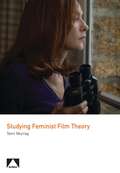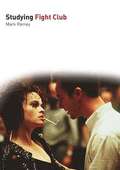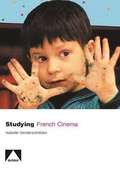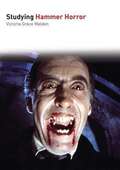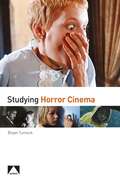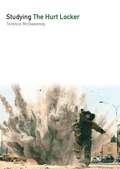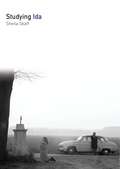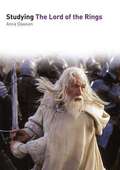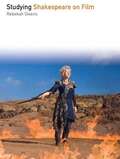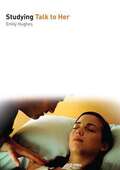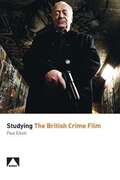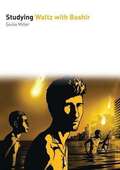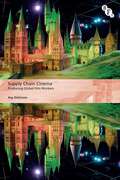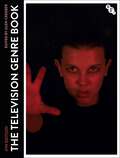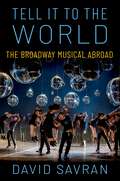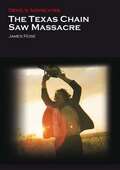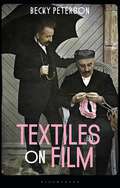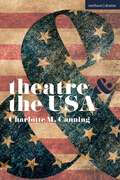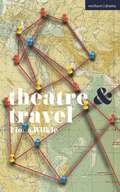- Table View
- List View
Stories between Tears and Laughter: Popular Czech Cinema and Film Critics
by Richard VojvodaWhile histories of Czech cinema often highlight the quality of Czechoslovak New Wave films made in the 1960s, post-socialist Czech cinema receives little attention. Through a methodology of historical reception, Stories between Tears and Laughter explores how attitudes towards post-socialist Czech cinema have shifted from viewing it as radical “art cinema” and more towards popular cinema. By analyzing publicity materials, reviews, and articles, Richard Vojvoda offers a new perspective on the notions of cultural value and quality that have been shaping the history of post-socialist Czech cinema.
Stories between Tears and Laughter: Popular Czech Cinema and Film Critics
by Richard VojvodaWhile histories of Czech cinema often highlight the quality of Czechoslovak New Wave films made in the 1960s, post-socialist Czech cinema receives little attention. Through a methodology of historical reception, Stories between Tears and Laughter explores how attitudes towards post-socialist Czech cinema have shifted from viewing it as radical “art cinema” and more towards popular cinema. By analyzing publicity materials, reviews, and articles, Richard Vojvoda offers a new perspective on the notions of cultural value and quality that have been shaping the history of post-socialist Czech cinema.
Studying City of God (Studying Films)
by Stephanie MuirA leading example of a resurgent Latin American cinema – 'la buena onda' – in the early twenty-first century, City of God was a huge international popular and critical success. A combination of intoxicating, Hollywood-style genre film-making and hard-hitting, social-realist subject matter it was hailed as a masterpiece at Cannes in 2002 and seen by over 3 million people in Brazil, including the Brazilian cabinet. In Studying City of God, Stephanie Muir considers: The historical and industrial context of City of God – a brief history of Latin American cinema is followed by a more detailed account of film-making in Brazil – from light-hearted travelogues to Cinema Novo and after – all in the context of increasing globalisation; Narrative and Genre – how the film uses the components of narrative in a complex way, ex-perimentally manipulating time while using traditional genre conventions that are highly recognisable to mainstream audiences; Film language – the formal elements of the film are dissected through a detailed illustrated analysis of the kinetic, scene setting opening sequence; Audience responses – from establishment critical reaction to fan-based Internet sites and student feedback; Representation and Ideology – just how 'authentic' can a film such as City of God hope to be? Does its style overwhelm its subject matter?
Studying Early and Silent Cinema (Auteur)
by Keith WithallIn this accessible introduction to early and silent cinema, which is currently enjoying a renaissance, both academically and in the popular imagination thanks to The Artist, Keith Withall provides both a comprehensive chronology of the period until the birth of sound and also a series of detailed case studies on the key films from the period – some well known (including Griffith's The Birth of a Nation, Eisenstein's Strike and Chaplin's The Kid), some perhaps less well familiar (including Murnau's The Last Laugh and Oscar Micheaux's Within Our Gates). As well as covering in detail the major film-making figures and nations of the period, the author also provides insights into the industry in less well documented areas. Throughout, the films and film-makers are placed in the context of rapid worldwide industrial change. (Please note this book is a revised and expanded version of Early and Silent Cinema: A Teacher's Guide, published by Auteur in 2007.)
Studying Feminist Film Theory (Auteur)
by Terri MurrayThis book is aimed at helping media and film studies teachers introduce the basics of feminist film theory. No prior knowledge of feminist theory is required, the intended readers being university undergraduate teachers and students of film and media studies. Areas of emphasis include spectatorship, narrative, and ideology. Many illustrative case studies from popular cinema are used to offer students an opportunity to consider the connotations of visual and aural elements of film, narrative conflicts and oppositions, the implications of spectator “positioning” and viewer identification, and an ideological critical approach to film. Explanations of key terminology are included, along with classroom exercises and practice questions. Each chapter begins with key definitions and explanations of the concepts to be studied, including some historical background where relevant. Case studies include film noir, Kathryn Bigelow’s Strange Days and the work of directors Spike Lee, Claire Denis, and Paul Verhoeven.Studying Feminist Film Theory is a revised and expanded version of Feminist Film Studies: A Teacher’s Guide, published by Auteur in 2007.
Studying Fight Club (Studying Films)
by Mark RameyFight Club is, on one level, pop-culture phenomena and on another, a deeply philosophical and satirical exploration of modern life. David Fincher's 1999 film (and Chuck Palahniuk's source novel) has had a huge impact on audiences worldwide leading to spoofs, homage, merchandising and numerous Internet fan sites. On initial release the film was met with wide hostility from critics who either failed to appreciate its satirical intent or believed the film failed to deliver on its satirical promise. Early in its DVD afterlife, however, a wider audience began to appreciate the film's significance and radical message. Although attracted by the film's playfulness and star wattage, however, many students struggle with its theoretical notions such as Capitalism, materialism, anarchy and so on. This is one film, which therefore merits a thoughtful and provocative analysis but also an accessible one, and Mark Ramey has provided just that.
Studying French Cinema (Auteur)
by Isabelle VanderscheldenTaking a text-led approach, with the emphasis on more recent popular films, Studying French Cinema is directed at non-specialists such as students of French, Film Studies, and the general reader with an interest in post-war French cinema. Each of the chapters focuses on one or more key films from the ground-breaking films of the nouvelle vague (Les 400 coups, 1959) to contemporary documentary (Etre et avoir, 2002) and puts them into their relevant contexts. Depending on the individual film, these include explorations of childhood, adolescence and coming of age (Les 400 coups, L'Argent de poche); auteur ideology and individual style (the films of Jean-Luc Godard and Agnes Varda); the representation of recent French history (Lacombe Lucien and Au revoir les enfants); transnational production practices (Le Pacte des loups); and popular cinema, comedy and gender issues (e.g. Le Diner de cons). Each film is embedded in its cultural and political context. Together, the historical discussions provide an overview of post-war French history to the present. Useful suggestions are made as to studies of related films, both those discussed within the book and outside.
Studying Hammer Horror (Studying Films)
by Victoria WaldenWhen Hammer Productions was formed in the 1920s, no one foresaw the impact this small, independent studio would have on the international film market. Christopher Lee's mesmerizing, animalistic, yet gentlemanly performance as Dracula, Frankenstein's Monster, and the Mummy were celebrated worldwide, and the Byronic qualities of Peter Cushing's Dr. Frankenstein, among his many other Hammer characters, proved impossible to forget. Hammer maintained consistent period settings, creating a timeless and enchanting aesthetic.Studying Hammer Horror treats Hammer as a quintessentially British product and through a study of its work investigates larger conceptions of national horror cinemas. The book examines genre, auteur theory, stardom, and representation within case studies of Curse of Frankenstein (1957), Twins of Evil (1971), and Hammer's latest film, Beyond the Rave (2008). Walden weighs Hammer's impact on the British film industry, past and present. Intended for students, fans, and general readers, this book transcends superficial preconceptions of Hammer horror in order to reach the essence of Hammer.
Studying Horror Cinema (Auteur)
by Bryan TurnockAimed at teachers and students new to the subject, Studying Horror Cinema is a comprehensive survey of the genre from silent cinema to its twenty-first century resurgence. Structured as a series of thirteen case studies of easily accessible films, it covers the historical, production, and cultural context of each film, together with detailed textual analysis of key sequences. Sitting alongside such acknowledged classics as Psycho and Rosemary’s Baby are analyses of influential non-English language films as Kwaidan, Bay of Blood, and Let the Right One In. The author concludes with a chapter on 2017’s blockbuster It, the most financially successful horror film of all time, making Studying Horror Cinema the most up-to-date overview of the genre available.
Studying The Hurt Locker (Studying Films)
by Terence McSweeneyIn this vibrant and dynamic book-length study drawing on a broad tapestry of research, Terence McSweeney offers an exploration of The Hurt Locker (2009), its stylistic and narrative devices, its cultural impact, its reception, and its relationship to the genre of the war film. McSweeney places the film in a richly textured historical, political, and industrial context, arguing that The Hurt Locker is part of a long tradition of films about American wars that play a considerable role in how audiences come to understand the conflicts that they depict. Thus, films about a nation’s wars are never “only a movie” but rather should be considered a cultural battleground themselves on which a war of representation is waged.
Studying Ida (Studying Films)
by Sheila SkaffPaweł Pawlikowski’s 2013 film Ida was exceptionally warmly received in the United States, culminating in the Academy Award for Film Not in the English Language, but it was not without controversy. Sheila Skaff’s introduction to the film explains the historical setting, including the violence that took place in the Polish countryside during World War II and was not exposed for sixty years, and provides political and cultural analysis to aid the reader in understanding the film’s setting and narrative. Skaff also touches on the influence of the film on current events in Poland, where censorship of it by an increasingly nationalist government has polarized the country. It also situates Ida within the contexts of Polish and world film history. Scene-by-scene analysis is accompanied in each chapter by background information that gives context to the aesthetic and narrative choices made by the director.
Studying The Lord of the Rings (Studying Films)
by Anna DawsonUnquestionably the first cinematic phenomenon of the twenty-first century, Peter Jackson's trilogy was a project of enormous artistic vision and financial risk. It is also a rich text for those studying film and media, perhaps for the first time. Studying The Lord of the Rings is the first book to consider the films in these terms, looking in turn at each of the major concepts: their complex origins and narrative structure; issues of representation masculinity, femininity and race; their generic patterns (to which genre do the films belong?) and thematic concerns; their industrial context from theatrical release to DVD extended editions; film language fusing classical mise-en-scène with cutting-edge technological practice. The aim throughout is to highlight critical debates and key terms, to relate these to the texts and to explore their stylistic and cultural impact. This Student Edition (a previously published Instructor's Edition is available) brings the story up to date with reflections on The Hobbit films.
Studying Shakespeare on Film (Studying Films)
by Rebekah OwensAimed at newcomers to literature and film, this book is a guide for the analysis of Shakespeare on film. Starting with an introduction to the main challenge faced by any director—the early-modern language—there follows exemplars for examining how that challenge is met using as case studies twelve films most often used in classroom teaching, including Romeo and Juliet, Macbeth, and The Tempest.The first chapter explores how a director can tell the story in a setting that embraces the expectations of realism in cinema, but still pays homage to the theatrical origins of the work. The second chapter discusses films in which the setting provides a visual analogy with the preoccupations of the story, but not at the expense of Shakespeare's language. The third chapter extends this to show how some films use recent history as a setting, adding a further layer of meaning to the story from the cultural resonances associated with that historical past. These films also rely on an assumption that Shakespeare is so well-known as to form a distinctive, easily recognized brand in the cinema marketplace. Thus, his work can be reimagined in completely different genres such as those films that are the subject of the final chapter.
Studying Talk to Her (Studying Films)
by Emily HughesTalk to Her (2002) is a hugely rich and interesting though ambiguous film that met with both popular success and critical acclaim. The film won an Oscar for best original screenplay and has been hailed by some critics as Pedro Almodóvar's masterpiece. Yet like most of Almodóvar's films, little is clear cut. The characters are complex and our affinity and empathy for them shifts throughout the film. In Studying Talk to Her, Emily Hughes provides an in-depth analysis of both the formal elements of the film (its narrative, genre, and auteur study) and the themes and issues it raises, discussing the social context of modern Spain and its old, traditional iconography; shifting attitudes towards gender; and, crucially, the film's uneasy, morally ambiguous depiction of rape and the spectator's reaction to it.
Studying the British Crime Film (Studying British Cinema)
by Paul ElliottEver since its inception, British cinema has been obsessed with crime and the criminal. One of the first narrative films to be produced in Britain, the Hepworth's 1905 short Rescued by Rover, was a fast-paced, quick-edited tale of abduction and kidnap, and the first British sound film, Alfred Hitchcock's Blackmail (1930), centered on murder and criminal guilt. For a genre seemingly so important to the British cinematic character, there is little direct theoretical or historical work focused on it. The Britain of British cinema is often written about in terms of national history, ethnic diversity, or cultural tradition, yet very rarely in terms of its criminal tendencies and dark underbelly. This volume assumes that, to know how British cinema truly works, it is necessary to pull back the veneer of the costume piece, the historical drama, and the rom-com and glimpse at what is underneath. For every Brief Encounter (1945) there is a Brighton Rock (2010), for every Notting Hill (1999) there is a Long Good Friday (1980).
Studying Waltz with Bashir (Studying Films)
by Giulia MillerOn its release in 2008, Ari Folman's animated documentary Waltz with Bashir was heralded as a brilliant and original exploration of trauma, and trauma's impact on memory and the recording of history. But it is surprising that although the film is seen through the eyes of one particular soldier, a viewpoint portrayed using highly experimental forms of animation, this has not prevented Waltz with Bashir from being regarded as both an "autobiographical" and "honest" account of the director's own experiences in the 1982 Lebanon war. In fact, the film won several documentary awards, and even those critics focusing on the representation of trauma suggest that this trauma must be authentic. In this sense, it is the documentary form rather than the animation that has had the most influence upon critics.As Studying Waltz with Bashir will show, it is the tension between the two forms that makes the film so complex and interesting, allowing for multiple themes and discourses to coexist, including Israel's role during the Lebanon War and the impact of trauma upon narrative, but also the representation of Holocaust memory and its role in the formation of Israeli identity. In addition to these themes that coexist by virtue of the film's unusual animated documentary format, Waltz with Bashir can also be discussed in relation to a broad range of contexts; for example, the representation of war in film, the history of Israeli Holocaust cinema, and recent trends in experimental animation, such as Richard Linklater's Waking Life (2001) and A Scanner Darkly (2006), as well as Folman's most recent live action/animation work The Congress (2013).
Supply Chain Cinema: Producing Global Film Workers (International Screen Industries)
by Kay DickinsonWhy are big budget films typically made across an array of seemingly dissociated sites? Supply Chain Cinema shows how the production journeys of such films exemplify the principles of the supply chain, whose core imperative is to nimbly and opportunistically manufacturing wherever is most amenable and efficient.Through extensive on-site investigations and in-depth interviews with film professionals, Kay Dickinson delivers nuanced insight into working practices in the UK and the UAE. Among the sites she examines is Warner Bros' permanent base at Leavesden Studios near London. From tax breaks designed to attract foreign projects to infrastructures, logistical support and expertise offered, she considers why Hollywood giants elect to make more of their films in Britain than in the USA. Dickinson goes on to show how the UK's ambitions to enlarge its creative economies has opened up a host of competitive advantages with British higher education increasingly fashioned to conform to the needs of border-hopping enterprise, thus generating a workforce keenly adapted to the demands of blockbuster moviemaking.
The Television Genre Book
In this new edition of The Television Genre Book, leading international scholars have come together to offer an accessible and comprehensive update to the debates, issues and concerns of the field. As television continues to evolve rapidly, this new edition reflects the ways in which TV has transformed in recent years, particularly with the emergence of online streaming services such as Netflix, Disney+, HBO Max and Amazon Prime. It also includes a new chapter on sports TV, and expanded coverage of horror, political thrillers, Nordic noir, historical documentary and docu-drama. With analyses of popular shows like Stranger Things, Killing Eve, The Crown, Chernobyl, Black Mirror, Fleabag, Breaking Bad and RuPaul's Drag Race, this book offers a comprehensive understanding of television genre for scholars and students alike.
Tell it to the World: The Broadway Musical Abroad
by David SavranWhat happens when Broadway goes abroad? Tell It to the World: The Broadway Musical Abroad offers a look at how the Broadway musical travels the world, influencing and even transforming local practices and traditions. It traces especially how the musical has been indigenized in South Korea and Germany, the commercial centers for Broadway musicals in East Asia and continental Europe. Both countries were occupied after World War II by the United States, which disseminated U.S. American popular music, jazz, movies, and musical theatre in the belief that these nations needed to rebuild their cultures in accordance with U.S. guidelines. By the 1990s, Broadway imports had become phenomenally popular in Seoul and Hamburg while home-grown musicals proliferated that adapted and transformed the prototypes that had been disseminated by the U.S. Although this book focuses on recent musicals, it also looks back through the twentieth century to plot the evolution of musical theatre in South Korea and Germany. Part One considers the key questions: What is a musical? Why is it the great success story of U.S. theatre? How has it been assimilated to musical theatre traditions around the world? Part Two focuses on musical theatre in South Korea, studying the import/export business in large-scale musicals about Korean history and innovative hybrid experiments that mix local performance traditions with the Broadway vernacular. Part Three moves to Europe to analyze the conflicted attitudes toward musicals in the German-speaking world. Its three chapters survey the history of musicals in Germany from 1945 until the fall of the Berlin Wall, the reconfiguration of musical theatre conventions by experimental directors, and finally the ground-breaking German-language productions of Broadway classics by Barrie Kosky and other innovative directors. In the twenty-first century, Broadway-style musical theatre has succeeded in becoming a lingua franca, the template for musical theatre around the world. This book shows how some of the most innovative, beautiful, and exciting musical theatre is being made outside the United States.
The Texas Chain Saw Massacre (Devil's Advocates)
by James RoseNo-one who has ever seen the original The Texas Chain Saw Massacre (1974) is ever likely to forget the experience. An intense fever dream (or nightmare), it is remarkable for its sense of sustained threat and depiction of an insane but nonetheless (dys)functional family on the furthest reaches of society who have regressed to cannibalism in the face of economic hardship. As well as providing a summary of the making of the film, James Rose discusses the extraordinary censorship history of the film in the UK (essentially banned for two decades) and provides a detailed textual analysis of the film with particular reference to the concept of 'the Uncanny'. He also situates the film in the context of horror film criticism (the 'Final Girl' character) and discusses its influence and subsequent sequels and remakes.
Textiles on Film
by Becky PetersonThe imagined worlds of the cinematic mise-en-scène are rich with textiles: fabrics drape over sets, serve as props, and develop mood and character as dress and décor. A much-needed examination of the cultural and emotional impact of textiles as mediated through cinematic technology, Textiles on Film broadens our understanding of the dynamic relationship between fabric and film.Drawing on scholarship across multiple disciplines and exploring a wide range of films-from lesser-known avant-garde films to big-budget Hollywood productions-this book will inspire scholars and students of film, fashion, and textiles. Close readings of on-screen textiles redirect meaning to that which is often overlooked, including depictions of gender expression, behind-the-scenes labor, and architectural and bodily ornamentation. Attentive to the social nuances of fabrics from polyester to velvet, and to the physical qualities of the textiles themselves, Becky Peterson unearths new possibilities for reading media and textile cultures.
Theatre and the USA (Theatre And)
by Charlotte CanningHow is the individual and the 'nation' constructed and promoted in American theatre? How does theatre enable a nation to invent and reinvent itself? Who are the 'people' in 'We the People'?This brief study examines the intersection of the USA's sense of self with its theatre, revealing how the two have an entangled history and a shared identity.Through case studies of six canonical plays and musicals, such as Uncle Tom's Cabin (1852), Oklahoma! (1943), Angels in America (1991), and Hamilton (2015), Theatre and the USA demonstrates how all six of these plays sparked controversy, spoke to their moment, and became canonical texts, arguing that that the histories of these plays are the history of the USA's theatrical infrastructure.
Theatre and Travel (Theatre And)
by Fiona WilkieWhat is the relationship between touring and other kinds of theatre work? How should theatre circulate, and how are we to understand this circulation? What impact do tour routes have beyond the dissemination of what is on stage? Whose travel stories are told within the theatre, and by whom? This concise study argues that we should pay more attention to how, why and where theatre travels. Moving away from prevailing metaphors of 'strolling players' and 'the circuit', this volume examines in more detail what theatre is doing when it tours, and why it matters.Enlivened with a wide range of examples – from Ancient Rome to internet livestreams, solo tours to national theatres, and Shakespeare to post-apocalyptic fiction – Theatre & Travel distinguishes between different versions of theatre touring to uncover both the possibilities and the inequalities that it entails. Proposing that travel is central to our understanding of theatre, the book asks what changes might need to happen to enable theatre to travel better in the world.
